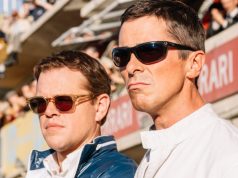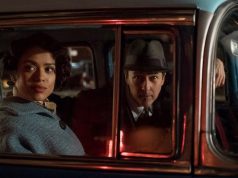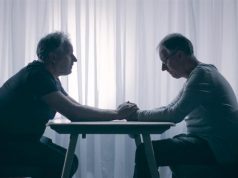While “The Diving Bell and the Butterfly” boasts some marvelous performances, I think I’m most impressed by the work of the cinematographer, Janusz Kaminski. He does things that are relatively common, but he does them at a higher level and with greater accuracy than most directors of photography would bother with.
The first 14 minutes are entirely from the perspective of a stroke victim in a hospital bed. To duplicate what the man’s eyes see, Kaminski moves things in and out of focus, leaves parts of the frame obscured altogether, and produces light flares, often all at once and at random intervals. The man is groggy; his eyesight is unreliable. For a solid 14 minutes we are trapped in his body with him, seeing exactly what he sees, the way he sees it. The effect is so well done that it’s easy to overlook just how difficult it must have been to achieve it.
With that introduction we are hooked into the story, the extraordinary but true account of Elle magazine editor Jean-Dominique Bauby, who suffered a stroke that left him in a rare condition called “locked-in syndrome”: His mind was intact, but the only part of his body that still worked was his left eye. With that eye he established a means of communication and dictated a book.
Let that be a lesson to all you procrastinating would-be writers. A guy who was paralyzed except for one eye managed to write a book. What’s your excuse?
Jean-Dominique Bauby is played here by Mathieu Amalric, bug-eyed and frog-like in his diminished capacity. After that opening sequence, the film alternates between Bauby’s perspective and more traditional cinematic angles; when we see him objectively it’s always a little startling to note how helpless he appears, considering how eloquent and dignified his thoughts (narrated to us in voice-over) have sounded. His deep intelligence and thoughtful soul don’t match his crippled body. It isn’t fair.
He is aided by Henriette (Marie-Josee Croze), a speech therapist who devises a way for him to communicate. One blink for “yes,” two for “no” is simple enough. Beyond that she recites the letters of the alphabet in order of how frequently they are used, and he blinks when she gets to the one he wants. The process repeats for the next letter in the word, and so forth. They get pretty good at it after a while, and once she has the first couple letters she can usually guess what the word is supposed to be, the way some cell phones do when you send text messages.
His friends call him Jean-Do (John Doe?). A few of them come to call on him in the hospital, though communicating with him is a frustrating, exhausting endeavor. His former lover, Celine (Emmanuelle Seigner), with whom he has three children, returns stoically to his bedside, at one point even helping him communicate with another former lover. Most touching is Jean-Do’s telephone conversation with his homebound father (Max von Sydow), who can ask questions and then must listen as Henriette painstakingly translates Jean-Do’s answers. “I miss you,” his dad says, simply and tenderly. What more can he say? Jean-Do’s medical condition is most devastating to Jean-Do himself, of course, but those who love him are not exactly spared.
The director is Julian Schnabel, whose two previous films “Basquiat” and “Before Night Falls” were also biographies of artists working under restrictive conditions. The screenwriter, Ronald Harwood, won an Oscar for “The Pianist,” which yet again featured a sensitive soul trapped by forces beyond his control.
All of these films celebrated, to use a movie critic’s cliche, the triumph of the human spirit. “The Diving Bell and the Butterfly” does it, too, but in a different way. We know that Jean-Do is not going to recover from his condition. That offer is never on the table. What we hope for instead, then, is that he will not let himself be beaten by his body’s betrayal. We root for the small victories and the eventual coming to terms with his new life. It is amazing that a story as sad as this one inherently is could be so uplifting, but that’s exactly what it is.
A- (1 hr., 52 min.; French with subtitles; )





